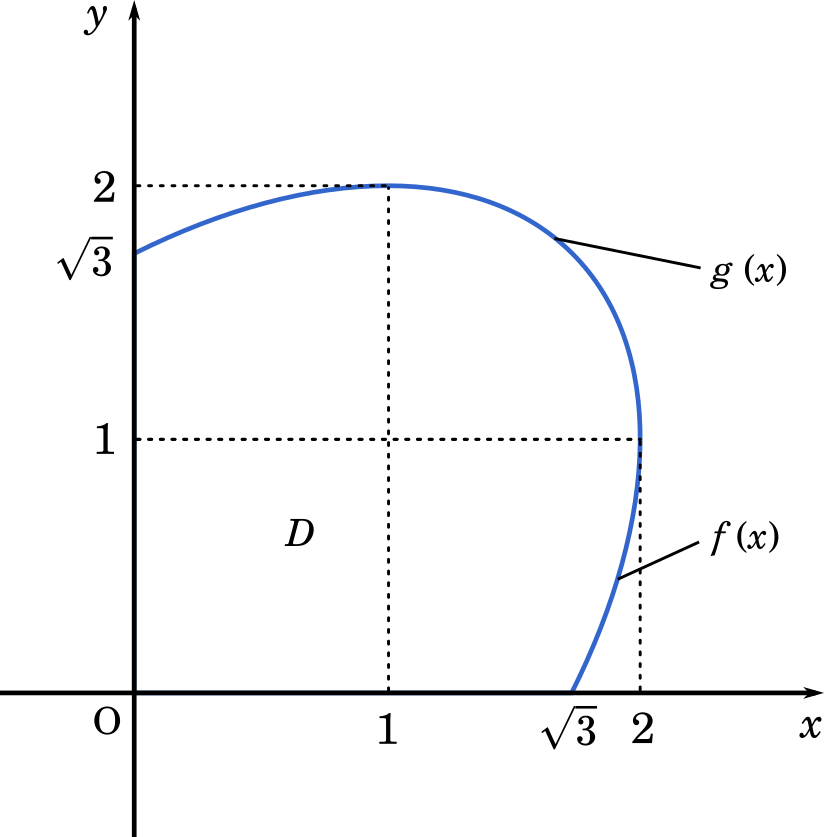増減表をもとに図形の面積を求める(東京都立大2020理学部第1問)
方程式 $x^2-xy+y^2=3$ の表す座標平面上の曲線で囲まれた図形を $D$ とする。
(1) この方程式を $y$ について解くと,
$y=\cfrac{1}{2}\{x\pm\sqrt{3(4-x^2)}\}$
となることを示しなさい。
(2) $\sqrt{3}\leqq x\leqq2$ をみたす実数 $x$ に対し,$f(x)=\cfrac{1}{2}\{x-\sqrt{3(4-x^2)}\}$ とする。$f(x)$ の最大値と最小値を求めなさい。また,そのときの $x$ の値を求めなさい。
(3) $0\leqq x\leqq2$ をみたす実数 $x$ に対し,$g(x)=\cfrac{1}{2}\{x+\sqrt{3(4-x^2)}\}$ とする。$g(x)$ の最大値と最小値を求めなさい。また,そのときの $x$ の値を求めなさい。
(4) 図形 $D$ の $x\geqq0$,$y\geqq0$ の部分の面積を求めなさい。
二次方程式の解の公式
(1)から始めます。ここは $y$ について解の公式を用いるだけです。
$x^2-xy+y^2=3$
$y^2-xy+x^2-3=0$
$y=\cfrac{x\pm\sqrt{x^2-4(x^2-3)}}{2}$
ルートの中は
$x^2-4(x^2-3)=x^2-4x^2+12$
$=12-3x^2=3(4-x^2)$
となるので
$y=\cfrac{1}{2}\{x\pm\sqrt{3(4-x^2)}\}$ (証明終わり)
式を微分する
(2)に進みます。
(1)で求めた関数は,プラスのときとマイナスのときで 2 つのグラフができます。今回の問題は,(2)と(3)でその 2 つのグラフの形を求め,(4)で積分して面積を求めるという流れです。
このままではグラフの形が分からないので,微分して極値を考えていきましょう。
いったん式変形してから微分します。
$f(x)=\cfrac{1}{2}\{x-\sqrt{3(4-x^2)}\}$
$=\cfrac{x}{2}-\cfrac{\sqrt{3}}{2}(4-x^2)^{\small{\frac{1}{2}}}$
式を微分すると
$f'(x)=\cfrac{1}{2}-\cfrac{\sqrt{3}}{4}(4-x^2)^{-\small{\frac{1}{2}}}(-2x)$

$=\cfrac{1}{2}+\cfrac{\sqrt{3}x}{2\sqrt{4-x^2}}$
極値を求めます。
$\cfrac{1}{2}+\cfrac{\sqrt{3}x}{2\sqrt{4-x^2}}=0$ として
$\cfrac{\sqrt{3}x}{2\sqrt{4-x^2}}=-\cfrac{1}{2}$
$\sqrt{3}x=-\sqrt{4-x^2}$ ・・・①
両辺を 2 乗します。ただし,符号に注意する必要があります。
$3x^2=4-x^2$
$4x^2=4$
$x=\pm1$
$x=1$ のとき①は
$\sqrt{3}\cdot1=-\sqrt{4-1^2}$
$\sqrt{3}=-\sqrt{3}$
となり,矛盾する。よって,$x=1$ は不適。
また,$x=-1$ のとき①は
$\sqrt{3}\cdot(-1)=-\sqrt{4-(-1)^2}$
$-\sqrt{3}=-\sqrt{3}$
恒等式が成り立つ。よって,$x=-1$
増減表は
$\def\arraystretch{1.5}\begin{array}{|c|c|c|c|c|c|}\hline x&(-1)&\cdots&\sqrt{3}&\cdots&2\\\hline f'(x)&(0)&&&+&\\\hline f(x)&&&0&\nearrow&1\\\hline\end{array}$





$f(\sqrt{3})=\cfrac{1}{2}\{\sqrt{3}-\sqrt{3(4-3)}\}$
$=\cfrac{1}{2}\cdot0=0$
$f(2)=\cfrac{1}{2}\{2-\sqrt{3(4-4)}\}$
$=\cfrac{1}{2}\cdot2=1$
したがって
最大値は $x=\sqrt{3}$ のとき,0。最小値は $x=2$ のとき,1。(答え)
もう一つの式を微分する
(3)に進みます。
$g(x)=\cfrac{1}{2}\{x+\sqrt{3(4-x^2)}\}$
$=\cfrac{x}{2}+\cfrac{\sqrt{3}}{2}(4-x^2)^{\small{\frac{1}{2}}}$
式を微分すると
$g'(x)=\cfrac{1}{2}+\cfrac{\sqrt{3}}{4}(4-x^2)^{-\small{\frac{1}{2}}}(-2x)$
$=\cfrac{1}{2}-\cfrac{\sqrt{3}x}{2\sqrt{4-x^2}}$
極値を求めます。
$\cfrac{1}{2}-\cfrac{\sqrt{3}x}{2\sqrt{4-x^2}}=0$ として
$\cfrac{\sqrt{3}x}{2\sqrt{4-x^2}}=\cfrac{1}{2}$
$\sqrt{3}x=\sqrt{4-x^2}$ ・・・②
両辺を 2 乗して
$3x^2=4-x^2$
$4x^2=4$
$x=\pm1$
(2)と同じように符号を検証します。
$x=1$ のとき,②は
$\sqrt{3}\cdot1=\sqrt{4-1}$
$\sqrt{3}=\sqrt{3}$
恒等式が成り立つ。
また,$x=-1$ のとき,②は
$\sqrt{3}(-1)=\sqrt{4-1}$
$-\sqrt{3}=\sqrt{3}$
となり,矛盾する。よって,不適。
増減表は
$\def\arraystretch{1.5}\begin{array}{|c|c|c|c|c|c|}\hline x&0&\cdots&1&\cdots&2\\\hline g'(x)&&+&0&-&\\\hline g(x)&\sqrt{3}&\nearrow&2&\searrow&1\\\hline\end{array}$
$g(0)=\cfrac{1}{2}\{0+\sqrt{3(4-0)}\}$
$=\cfrac{1}{2}\cdot2\sqrt{3}=\sqrt{3}$
$g(1)=\cfrac{1}{2}\{1+\sqrt{3(4-1)}\}$
$=\cfrac{1}{2}(1+3)=2$
$g(2)=\cfrac{1}{2}\{2+\sqrt{3(4-4)}\}$
$=1$
したがって
最大値は $x=1$ のとき,2。最小値は $x=2$ のとき,1。(答え)
置換積分
(4)に進みます。

(2)と(3)で作った増減表をもとにグラフを描くと上のようになります。もちろん,実際に試験問題を解いているときには,おおまかな形で構いません。
ここから,面積を求めるために,$f(x)$ を $g(x)$ を使って積分していくことになりますが,先に $\sqrt{3(4-x^2)}$ の部分を処理しておいた方が良さそうです。
$\displaystyle\int\sqrt{3(4-x^2)}\space dx$
$\displaystyle=\sqrt{3}\int\sqrt{4-x^2}\space dx$
ルートの中が ○○ $-x^2$ という形になっていたら,$\sin$ で置換します。パターンとして覚えておくべきものです。
ただし,今回は $x=2\sin\theta$ で置換します。


$x=2\sin\theta$ として
$dx=2\cos\theta\space d\theta$
$\displaystyle\sqrt{3}\int\sqrt{4-4\sin^2\theta}\cdot2\cos\theta\space d\theta$
$\displaystyle\sqrt{3}\int\sqrt{4(1-\sin^2\theta)}\cdot2\cos\theta\space d\theta$
$=\displaystyle4\sqrt{3}\int\sqrt{1-\sin^2\theta}\cdot\cos\theta\space d\theta$
$=\displaystyle4\sqrt{3}\int\sqrt{\cos^2\theta}\cdot\cos\theta\space d\theta$
$=\displaystyle4\sqrt{3}\int\cos^2\theta\space d\theta$
$\sin^2$ や $\cos^2$ が来たら,半角の公式に持ち込みましょう。
$=\displaystyle4\sqrt{3}\int\cfrac{1+\cos2\theta}{2}\space d\theta$
$=\displaystyle2\sqrt{3}\int1+\cos2\theta\space d\theta$
$=2\sqrt{3}\Big(\theta+\cfrac{1}{2}\sin2\theta\Big)+C$
$=\sqrt{3}(2\theta+\sin2\theta)+C$ ($C$は積分定数) ・・・③
面積を求めましょう。式は以下のようになります。
$\displaystyle S=\int_0^2 g(x)\space dx-\int_{\sqrt{3}}^2f(x)\space dx$
いったん,二つに分けて計算します。
$\displaystyle \int_0^2 g(x)\space dx$
$\displaystyle=\cfrac{1}{2}\int_0^2 x\space dx+\cfrac{1}{2}\int_0^2\sqrt{3(4-x^2)}\space dx$
③を利用して
$\def\arraystretch{1.5}\begin{array}{|c|ccc|}\hline x&0&\rightarrow&2\\\hline \theta&0&\rightarrow&\frac{\pi}{2}\\\hline\end{array}$
$=\cfrac{1}{2}\Big[\cfrac{x^2}{2}\Big]_0^2+\cfrac{\sqrt{3}}{2}\Big[2\theta+\sin2\theta\Big]_0^{\small{\frac{\pi}{2}}}$
$=\cfrac{1}{2}(2-0)+\cfrac{\sqrt{3}}{2}\pi$
$=1+\cfrac{\sqrt{3}}{2}\pi$
また
$\displaystyle \int_{\sqrt{3}}^2 f(x)\space dx$
$\displaystyle=\cfrac{1}{2}\int_{\sqrt{3}}^2 x\space dx-\cfrac{1}{2}\int_{\sqrt{3}}^2\sqrt{3(4-x^2)}\space dx$
③を利用して
$\def\arraystretch{1.5}\begin{array}{|c|ccc|}\hline x&\sqrt{3}&\rightarrow&2\\\hline \theta&\frac{\pi}{3}&\rightarrow&\frac{\pi}{2}\\\hline\end{array}$
$=\cfrac{1}{2}\Big[\cfrac{x^2}{2}\Big]_{\sqrt{3}}^2-\cfrac{\sqrt{3}}{2}\Big[2\theta+\sin2\theta\Big]_{\small{\frac{\pi}{3}}}^{\small{\frac{\pi}{2}}}$
$=\cfrac{1}{2}\Big(2-\cfrac{3}{2}\Big)-\cfrac{\sqrt{3}}{2}\Big(\pi+0-\cfrac{2\pi}{3}-\cfrac{\sqrt{3}}{2}\Big)$
$=\cfrac{1}{4}-\cfrac{\sqrt{3}}{2}\Big(\cfrac{\pi}{3}-\cfrac{\sqrt{3}}{2}\Big)$
$=\cfrac{1}{4}-\cfrac{\sqrt{3}}{6}\pi+\cfrac{3}{4}$
$=1-\cfrac{\sqrt{3}}{6}\pi$
したがって,面積は
$S=1+\cfrac{\sqrt{3}}{2}\pi-1+\cfrac{\sqrt{3}}{6}\pi$
$=\cfrac{2\sqrt{3}}{3}\pi$ (答え)
SNSでシェア